|
The Dalles & Southern Railroad Great Southern Railroad |
|
|
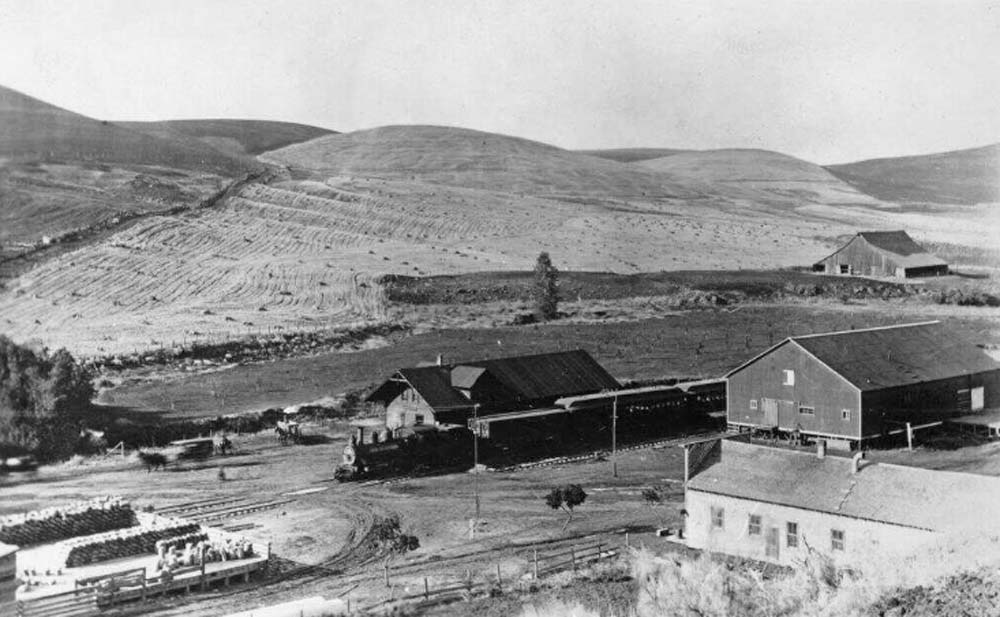 |
|
A Great Southern Railroad mixed train in Dufur, Oregon. |
|
|
History A visionary businessman from Seattle, Washington, named John Heimrich dreamed up the concept of building a railroad from some point in Washington south to San Francisco, California, in the years right around 1900. A business partner finally prompted Heimrich to launch the venture, and on 3 March 1904 he incorporated the Great Southern Railroad. The problems and expenses involved with crossing the Columbia River, plus uncertainty over fixing a northern terminus for the road in Washington, caused Heimrich to start construction south from The Dalles, Oregon. Heimrich named his son J.G. Heimrich as the railroad's manager, and under his direction grading commenced on 8 March 1904. The railroad placed the first thirty miles of the line to Dufur, Oregon, in service sometime between September and December 1905. Construction on the railroad paused for several critical years while the small railroad settled down to hauling mostly agricultural and some passenger traffic. The first published timetable in 1908 showed the train leaving Dufur at 8:15 a.m. and arriving at The Dalles two hours later, with the return trip leaving The Dalles at 2:00 p.m. and arriving back in Dufur at 4:00 p.m. Wheat provided the bulk of the freight traffic, supplemented by smaller amounts of lumber and other commodities. |
|
|
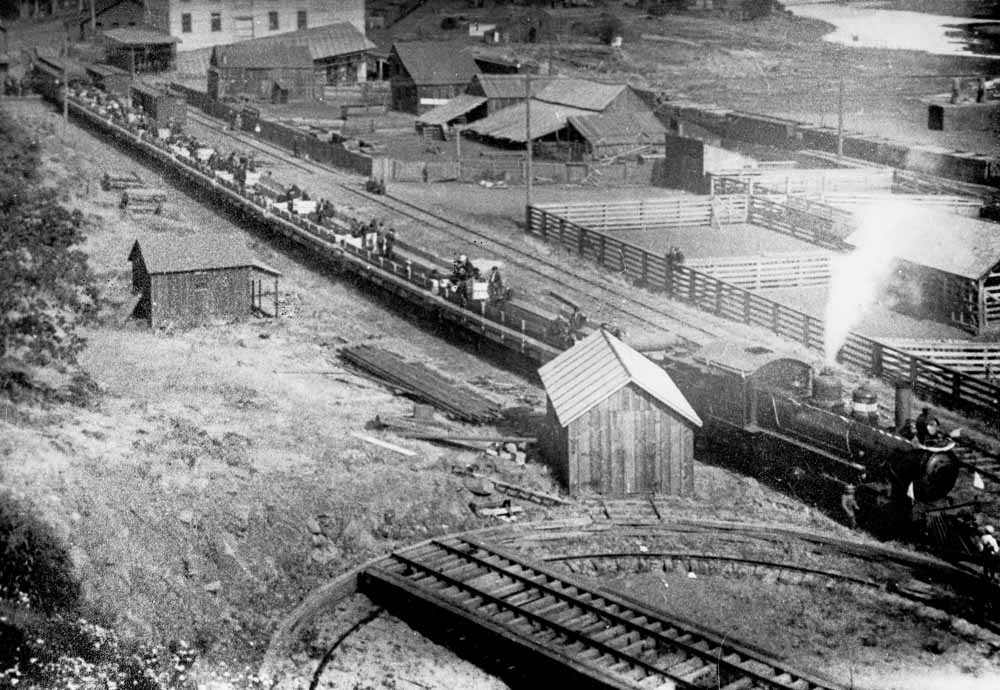 |
|
A Great Southern special excursion train preparing to depart The Dalles in the summer of 1907. John T. Labbe Collection of Logging and Railroad Photographs, 1892-2010, Washington State Archives, Digital Archives, http://www.digitalarchives.wa.gov. |
|
|
|
The delay in pushing the railroad any farther south proved costly for the company, as in 1909 subsidiaries of both the Union Pacific and Spokane, Portland & Seattle railroads
started blasting their grades down opposite banks of the Deschutes River just east of the Great Southern route. By the time Heimrich obtained additional capital to extend his road in
1911 the two mainline roads were just about to complete their joint line into Bend, Oregon, which would effectively close off the Great Southern's dreams of reaching that point or beyond.
When the Great Southern resumed construction south of Dufur in May 1911 its plans had been scaled back to a projected 20-mile long line designed to access the wheat fields and timber stands
in Tygh Valley, Juniper Flat, and Smock Prairie regions. The railroad, however, only managed to build another eleven miles of track over the next two years, with a final terminus of
Friend, Oregon, 40.79 miles from The Dalles, reached in late 1912. The railroad had cost $625,691 to build and $32,519 to equip, and used 38 bridges. The completed Great Southern Railroad in 1913 rostered two locomotives, two passenger cars, nine boxcars, three livestock cars, and nine flatcars. The timetable issued for 1916 showed the train departing The Dalles at 8:00 a.m. and arriving at Friend at 10:45 a.m., with the return trip departing Friend at 1:00 p.m. and arriving back at The Dalles at 3:45 p.m. The railroad built a turntable at Friend to turn the locomotives at the end of each trip. Burlap shortages during the first world war caused grain shipments to transition from sacks to bulk shipments loaded in grain elevators built along the railroad at Dufur, Boyd, Rice, and Emerson. The railroad reached its high water mark in terms of revenue in 1921. |
|
|
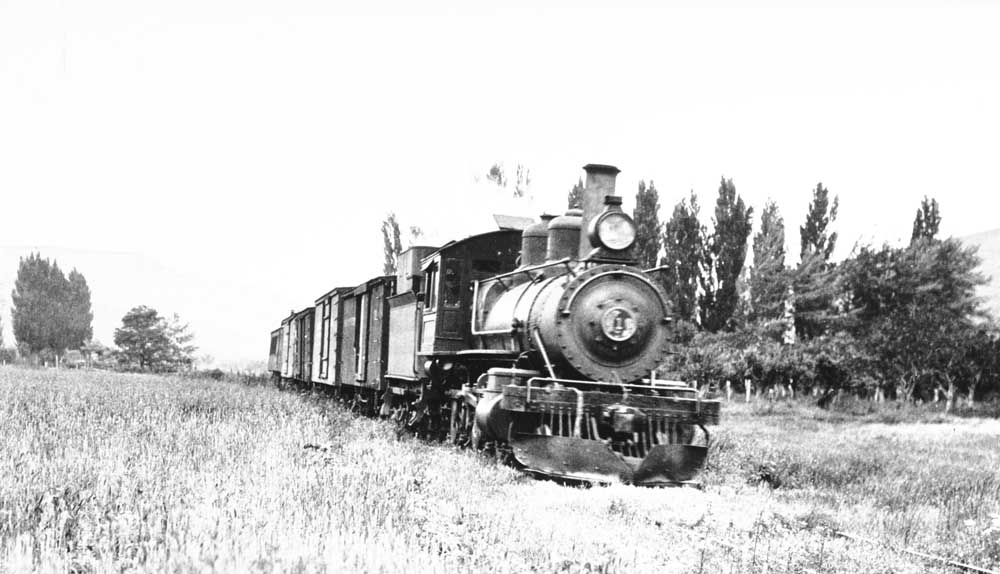 |
|
Great Southern locomotive #1 fifteen miles south of The Dalles in July 1916. John T. Labbe Collection of Logging and Railroad Photographs, 1892-2010, Washington State Archives, Digital Archives, http://www.digitalarchives.wa.gov. |
|
|
|
The Great Southern Railroad entered a steep decline as the 1920s progressed, mostly due to improving roads and trucks siphoning off the passenger and
wheat traffic that sustained the railroad. Regular operations of the line ceased on 5 January 1928. John Heimrich had died in 1913, but his will stipulated his
estate would be used to sustain operations of his railroad for another fifteen years before his assetts could be divided between his two children, J.R. and his
sister Rose Hull. John's widow Elizabeth ended up enforcing that provision for another two years beyond its expiration, up to the point of her death in 1930.
Rose promtply asked J.R. for her share of the inheritance, but by this time the estate had been bled completely dry trying to keep the railroad going. Rose filed
legal action against her brother trying to recover something, and in 1931 the courts awarded the railroad to she and her husband Steven. Rose and Steven Hull inherited a railroad in terrible physical condition and mired deeply in debt and with little to no business prospects, compounded by the fact that the railroad had sold off all of its equipment during the legal proceedings to pay off back taxes. The couple were not willing to give up on the railroad, and over the next several years they made a valiant attempt to revive the operation. The biggest hope for additional business came in 1932 and 1933 when the couple, working in conjunction with the Wasco Pine Lumber Company, secured a large U.S. Forest Service timber sale south and west of Friend. The Hulls apparently deeded the railroad over to the lumber company as part of these plans, as on 11 December 1933 Wasco Pine Lumber incorporated The Dalles & Southern Railroad to take over the Great Southern Railroad. The Dalles & Southern bought a used locomotive and started grading a railroad line from Friend towards the timber sale, but only got a little more than five and a half miles of grade completed before economic realities set in and the company abandoned both the railroad extension and the timber sale. |
|
|
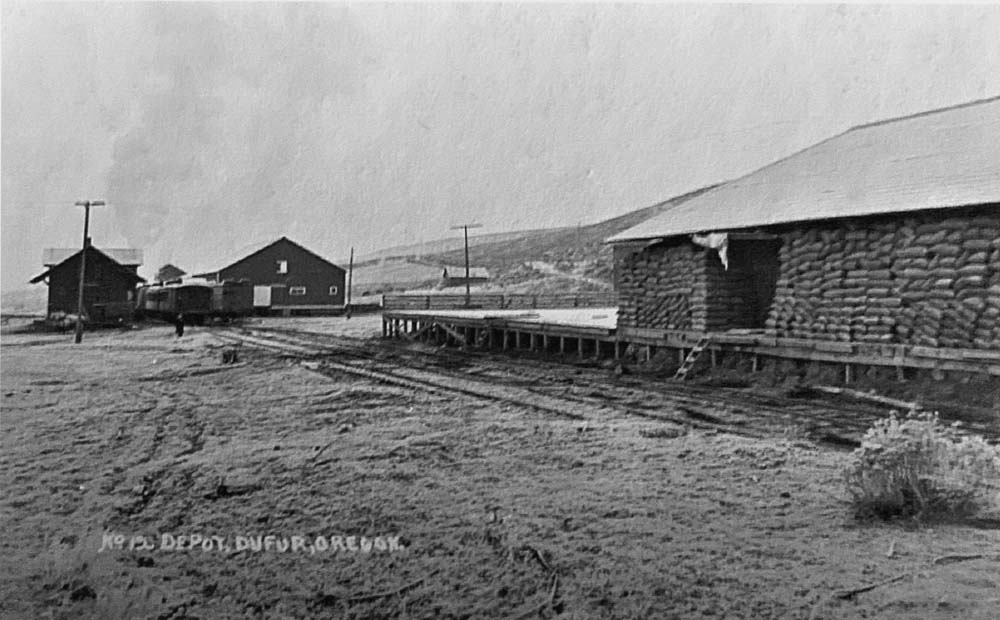 |
|
Bags of wheat are piled high in the railroad's freight depot at Dufur in this old postcard view. Jeff Moore collection. |
|
|
|
The Dalles & Southern was destined to only have a life span of around two and a half years, as without the promised lumber traffic it had effectively
no other business left to handle, and the property needed a complete rebuild to continue operations. The railroad formally abandoned the railroad on 30 September 1935
and ceased its corporate existence on or about 1 May 1936, and scrappers removed all the rails in around this time. Remnants of the railroad still in existence
almost ninty years after the operation disappeared include the railroad's The Dalles depot, since moved from its original location and now home to a gift shop
and some apartments, stretches of grade, several reasonably intact trestles, and the turntable pit at Friend. |
|
|
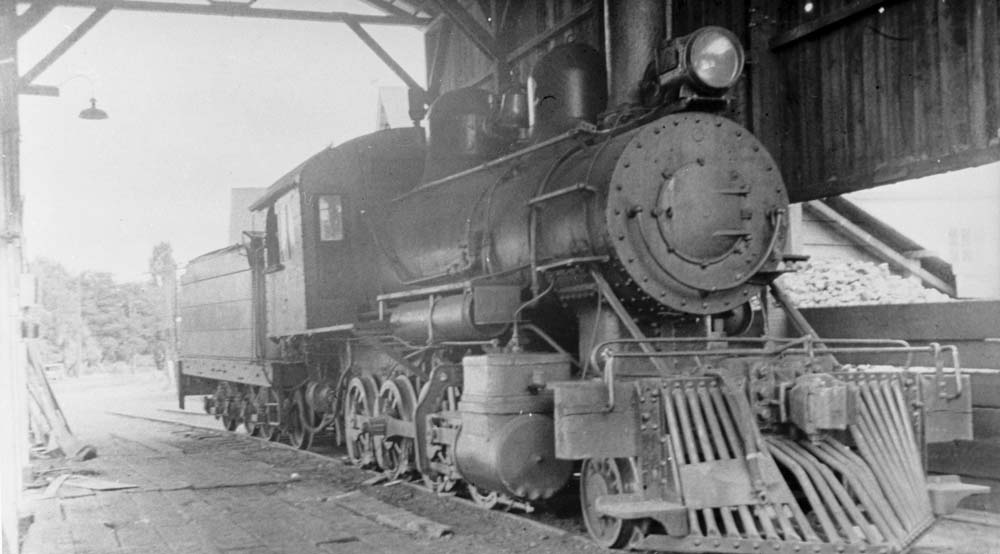 |
|
The Dalles & Southern #2 at Dallas, Oregon, on 7 August 1937. Boynton photo, John T. Labbe Collection of Logging and Railroad Photographs, 1892-2010, Washington State Archives, Digital Archives, http://www.digitalarchives.wa.gov. |
|
|
|
Map 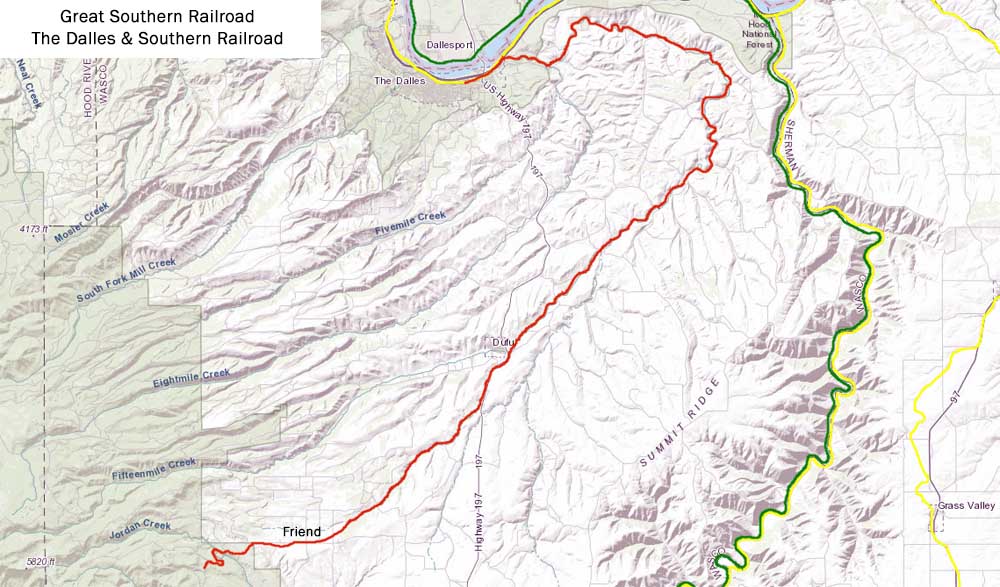
Records are not complete enough to indicate if the railroad grade built beyond Friend ever had rails on it or not.
|
|
|
Locomotive Rosters Great Southern Railroad 1- Baldwin 2-6-0, former Richmond, Fredericksburg & Potomac, 2- Baldwin 4-6-0, former Western New York and Pennsylvania. 4- Plymouth gas mechanical switcher, built circa 1930. The Dalles & Southern Railroad 2- Lima 2-8-0, Built 1908, former P.R. Lewis Construction Company. |
|
|
|
References Books "Encyclopedia of Western Railroad History Volume III, Oregon/Washington" by Donald B. Robertson, Caxton, 1995. Other Resources include interpretive materials and displays in the Wasco County Museum near The Dalles, Oregon. |
|
|
|
More on the Web Wikipedia article on the Great Southern Railroad Another website about The Dalles depot |
|
|